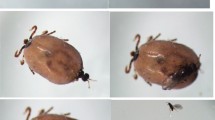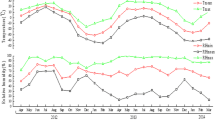Abstract
Amblyomma incisum Neumann is a major tick species in the Atlantic Forest of Brazil. Tapir is the main host for adult ticks and a high aggressiveness of nymphs to humans has been reported. In this work data on the biology and life cycle of this tick species is presented for the first time. It was shown that horse is a suitable host for A. incisum adults and rabbit for larvae and nymphs. It was also shown that A. incisum is a big tick species (mean engorged female weight of 1.96 g) with a long life cycle which lasts 262.3 days when maintained at 27°C and 85% RH. These laboratory conditions were, however, inappropriate and egg hatching rate (1.2%) was very low. Nevertheless egg hatching of ticks in a forest patch increased considerably (72.2%) indicating that this A. incisum population is highly dependent on a forest-like environment.

Similar content being viewed by others
References
Aguirre DH, Mangold AJ, Cafrune MM, Guglielmone AA (2005) Amblyomma tigrinum (Acari: Ixodidae): new data on hosts and biology of immature stages and on DNA composition. Vet Parasitol 134:267–272. doi:10.1016/j.vetpar.2005.07.023
Balashov YS (1972) Bloodsucking ticks (Ixodoidea)—vectors of diseases of man and animals (Translation from Russian). Misc publ Entomol Soc Am 8:161–362
Barros-Battesti DMB (2006) Introdução. In: Barros-Battesti DMB, Arzua M, Bechara GH (eds) Carrapatos de importância medico-veterinária da região neotropical: um guia ilustrado para identificação de espécies. Vox/ICTTD-3/Butantan, São Paulo/BR pp 1–4
Bennett GF (1974) Oviposition of Boophilus microplus (Canestrini) (Acarina: Ixodidae). Acarologia 16:1652–1661
Castagnolli KC, Figueiredo LB, Santana DA, Castro MB, Romano MA, Szabó MPJ (2003) Acquired resistance of horses to Amblyomma cajennense (Fabricius, 1787) ticks. Vet Parasitol 117:271–283. doi:10.1016/j.vetpar.2003.09.004
Chacon SC, Faccini JLH, Bittencourt VREP (2004) Successful infestation by Amblyomma pseudoconcolor and A. cooperi (Acari: Ixodidae) on horses. Ann N Y Acad Sci 1026:232–234. doi:10.1196/annals.1307.035
Daemon E, Ishizuka AC (1995) Laboratory investigations on the effects of different temperatures on the nymphal molting of Amblyomma cajennense (Acarina: Ixodidae). Rev Bras Cienc Vet 2(1):7–9
Guglielmone AA, Mangold AJ, Garcia MD (1991) The life cycle of Amblyomma parvum Aragão, 1908 (Acari: Ixodidae) under laboratory conditions. Exp Appl Acarol 13(2):129–136. doi:10.1007/BF01193663
Guimarães JH, Tucci CE, Barros-Battesti DM (2001) Ectoparasitos de Importância Veterinária. Editoras Plêiade/FAPESP, São Paulo
Klompen JSH, Black WCIV, Keirans JE, Oliver JH Jr (1996) Evolution of ticks. Annu Rev Entomol 41:141–161. doi:10.1146/annurev.en.41.010196.001041
Labruna LM, Souza SLP, Menezes AC, Horta MC, Pinter A, Gennari SM (2002) Life cycle and host specificity of Amblyomma tigrinum (Acari: Ixodidae) under laboratory conditions. Exp Appl Acarol 24:115–125. doi:10.1023/A:1020957122256
Labruna MB, Fugisaki EYM, Pinter A, Duarte JMB, Szabó MPJ (2003) Life cycle and host specificity of Amblyomma triste (Acari: Ixodidae) under laboratory conditions. Exp Appl Acarol 30:305–316. doi:10.1023/B:APPA.0000006514.02451.6d
Labruna MB, Pinter A, Teixeira RHF (2004) Life cycle of Amblyomma cooperi (Acari: Ixodidae) using capybaras (Hydrochaeris hydrochaeris) as hosts. Exp Appl Acarol 32:79–88. doi:10.1023/B:APPA.0000018228.05088.26
Labruna MB, Keirans JE, Camargo LM, Ribeiro AF, Soares RM, Camargo EP (2005) Amblyomma latepunctatum, a valid tick species (Acari: Ixodidae) long misidentified with both Amblyomma incisum and Amblyomma scalpturatum. J Parasitol 91(3):527–541. doi:10.1645/GE-446R
Pinter A, Dias RA, Gennari SM, Labruna MB (2004) Study of the seasonal dynamics, life cycle, and host specificity of Amblyomma aureolatum (Acari: Ixodidae). J Med Entomol 41(3):324–332
Prata MCA, Alonso LS, Sanavria A (1996) Biological parameters of the nymphal stage of Amblyomma cajennense (Fabricius, 1787) (Acarina: Ixodidae) in rabbits. Rev Bras Cienc Vet 4(1):5–8
Prata MCA, Alonso LS, Sanavria A (1997) Biological parameters of the larval stage of Amblyomma cajennense (Fabricius, 1787) (Acarina: Ixodidae) in rabbits. Rev Bras Cienc Vet 4(1):5–8
Rodrigues DS, Carvalho HA, Fernades AA, Freitas CMV, Leite RC, Oliveira PR (2002) Biology of Amblyomma aureolatum (Pallas, 1772) (Acari: Ixodidae) on some laboratory hosts in Brazil. Mem Inst Oswaldo Cruz 97(7):853–856
Sanavria A, Prata MCA, Morais MC, Alonso LS (1996) Determinação de alguns parâmetros biológicos de Amblyomma cajennense (Fabricius, 1787)(Acari: Ixodidae) em infestação artificial de eqüinos (Determination of some biological parameters of Amblyomma cajennense (Fabricius, 1787)(Acari: Ixodidae) in equines artificial infestation). Arq Fac Vet UFRGS Porto Alegre 24(2):78–86
Sanches GS, Bechara GH, Garcia MV, Labruna MB, Szabó MPJ (2008) Biological aspects of Amblyomma brasiliense Aragão 1908 (Acari: Ixodidae) under laboratory conditions. Exp Appl Acarol 44:43–48. doi:10.1007/s10493-007-9127-5
Szabó MPJ, Labruna MB, Vogliotti A, Duarte JMB (2006a) Ticks (Acari: Ixodidae) on small red brocket deer (Mazama bororo Duarte) along deer trails in the Atlantic rain forest of southeastern Brazil. Syst Appl Acarol 11:41–45
Szabó MPJ, Labruna MB, Castagnolli KC, Garcia MV, Pinter A, Veronez VA, Magalhães GM, Castro MB, Vogliotti A (2006b) Ticks (Acari: Ixodidae) parasitizing humans in an Atlantic rainforest reserve of Southeastern Brazil with notes on host suitability. Exp Appl Acarol 39:339–346. doi:10.1007/s10493-006-9013-6
Szabó MPJ, Labruna MB, Garcia MV, Castagnolli KC, Pacheco RC, Castro MB, Veronez VA, Magalhães GM, Vogliotti A, Duarte JMB (2009) Ecological aspects of free-living ticks (Acari: Ixodidae) on animal trails in an Atlantic rainforest of Southeastern Brazil. Ann Trop Med Parasitol (in press)
Acknowledgments
Financial support was given by FAPESP and FUNADESP. Authors would like to thank Parque Estadual Intervales (institution and staff) for logistical support. We are also indebted to Aparecido Dias de Oliveira for guiding researchers inside the park during tick collection. Part of this work has been facilitated through the International Consortium on Ticks and Tick-borne Diseases (ICTTD-3) Coordination Action financed by the INCO program of the European Commission Project No. 510561.
Author information
Authors and Affiliations
Corresponding author
Rights and permissions
About this article
Cite this article
Szabó, M.P.J., de F. Pereira, L., Castro, M.B. et al. Biology and life cycle of Amblyomma incisum (Acari: Ixodidae). Exp Appl Acarol 48, 263–271 (2009). https://doi.org/10.1007/s10493-008-9234-y
Received:
Accepted:
Published:
Issue Date:
DOI: https://doi.org/10.1007/s10493-008-9234-y




